Packera cana (Woolly Groundsel)
| Also known as: | Gray Ragwort, Silvery Ragwort |
|---|---|
| Genus: | Packera |
| Family: | Asteraceae (Aster) |
| Life cycle: | perennial |
| Origin: | native |
| Status: |
|
| Habitat: | sun; dry sandy or rocky soil; prairies, plains, rocky slopes, outcrops |
| Bloom season: | May - June |
| Plant height: | 1 to 3 feet |
| Wetland Indicator Status: | none |
| MN county distribution (click map to enlarge): |  |
| National distribution (click map to enlarge): |  |
Pick an image for a larger view. See the glossary for icon descriptions.
Detailed Information
Flower: 

![[photo of flowers]](/udata/r9ndp23q/jt/packera-cana-4-t.jpg) An erect cluster of 8 to 15 flowers that is more or less flat across the top in profile, the stalks long and slender, often all attached at the very tip of the stem, though a few stalks may be branched. Flowers are ¾ to 1 inch across, daisy-like with a golden yellow center disk and 8, 10 or 13 yellow rays (petals).
An erect cluster of 8 to 15 flowers that is more or less flat across the top in profile, the stalks long and slender, often all attached at the very tip of the stem, though a few stalks may be branched. Flowers are ¾ to 1 inch across, daisy-like with a golden yellow center disk and 8, 10 or 13 yellow rays (petals).
![[photo of phyllaries]](/udata/r9ndp23q/jt/packera-cana-11-t.jpg) Cupping the flower head are 13 or 21 narrow, floral bracts (phyllaries), usually green or sometimes purplish, with sparse to dense matted hairs especially around the tip end. Flower stalks are densely covered in matted hairs; a few scale-like bracts are scattered along the stalk.
Cupping the flower head are 13 or 21 narrow, floral bracts (phyllaries), usually green or sometimes purplish, with sparse to dense matted hairs especially around the tip end. Flower stalks are densely covered in matted hairs; a few scale-like bracts are scattered along the stalk.
Leaves and stems: 



![[photo of basal leaf]](/udata/r9ndp23q/jt/packera-cana-19-t.jpg) Leaves are mostly erect, 1 to 2 inches long, up to about ½ inch wide, toothless. Both upper and lower surfaces are densely covered in matted white hairs, especially the underside, the upper surface sometimes becoming smooth with age. Basal leaves are in a dense clump. Basal and the lowest stem leaves are generally lance-elliptic with a blunt to rounded tip, tapering at the base to a long, slender stalk.
Leaves are mostly erect, 1 to 2 inches long, up to about ½ inch wide, toothless. Both upper and lower surfaces are densely covered in matted white hairs, especially the underside, the upper surface sometimes becoming smooth with age. Basal leaves are in a dense clump. Basal and the lowest stem leaves are generally lance-elliptic with a blunt to rounded tip, tapering at the base to a long, slender stalk.
![[photo of stem and upper stem leaf]](/udata/r9ndp23q/jt/packera-cana-7-t.jpg) Mid to upper stem leaves are few, widely spaced, lance-oblong in outline, deeply lobed to coarsely toothed, and stalkless or nearly so. Stems are stout, unbranched, single or multiple from the base, weakly ridged, and densely covered in matted white hairs. The woolly hairs give the whole plant a silvery cast.
Mid to upper stem leaves are few, widely spaced, lance-oblong in outline, deeply lobed to coarsely toothed, and stalkless or nearly so. Stems are stout, unbranched, single or multiple from the base, weakly ridged, and densely covered in matted white hairs. The woolly hairs give the whole plant a silvery cast.
Fruit: 
Fruit is a dry seed with a tuft of hair (pappus) to carry it off in the wind.
Notes:
A rare species in Minnesota, Woolly Groundsel was first collected near Fertile in Polk County in 1942 and not seen again until the 1990s, when 4 sites in Marshall and Polk counties were discovered during biological surveys of our northwest counties. According to the DNR, these 4 locations were thought to be the only known populations in the state and it was subsequently listed as an Endangered species in 1996. A new site was found in 2015 just a few miles from the original collection site near Fertile. Perhaps more will be found in the near future, but the rocky prairie habitat favored by this species is vulnerable to gravel mining and keeps it at risk. While the flowers of Woolly Groundsel resemble those of other Packera species, it is easily distinguished by the dense covering of woolly hairs on leaves and stems, which give the plant a silvery cast.
Native Plant Nurseries, Restoration and Landscaping Services ↓
More photos
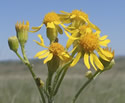 Woolly Groundsel plant
Woolly Groundsel plant Woolly Groundsel plant
Woolly Groundsel plant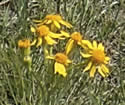 Woolly Groundsel prairie habitat
Woolly Groundsel prairie habitat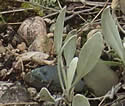 Woolly Groundsel rocky slope habitat
Woolly Groundsel rocky slope habitat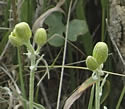 budding plant
budding plant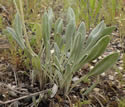 basal leaf clump
basal leaf clump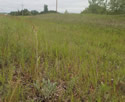 rediscovered in Polk County
rediscovered in Polk County
Photos courtesy John Thayer taken in Polk County and in North Dakota. Photos courtesy Peter M. Dziuk taken in Montana.
Comments
Have you seen this plant in Minnesota, or have any other comments about it?
on: 2020-06-12 16:17:19
I saw this flower on Britton Peak of the North Shore of MN
on: 2020-06-12 17:36:10
Hoa, Packera cana is a dry plains species and is only known from a few locations in northwest MN. It would be quite the find on the North Shore, but I suspect you saw a different species. If you have any photos and would like confirmation, I suggest posting them on the Minnesota Wildflowers Facebook page.
on: 2021-08-11 00:31:34
There are some plants I found two years ago on one of the WMAs just east of Fertile. Not many though.






